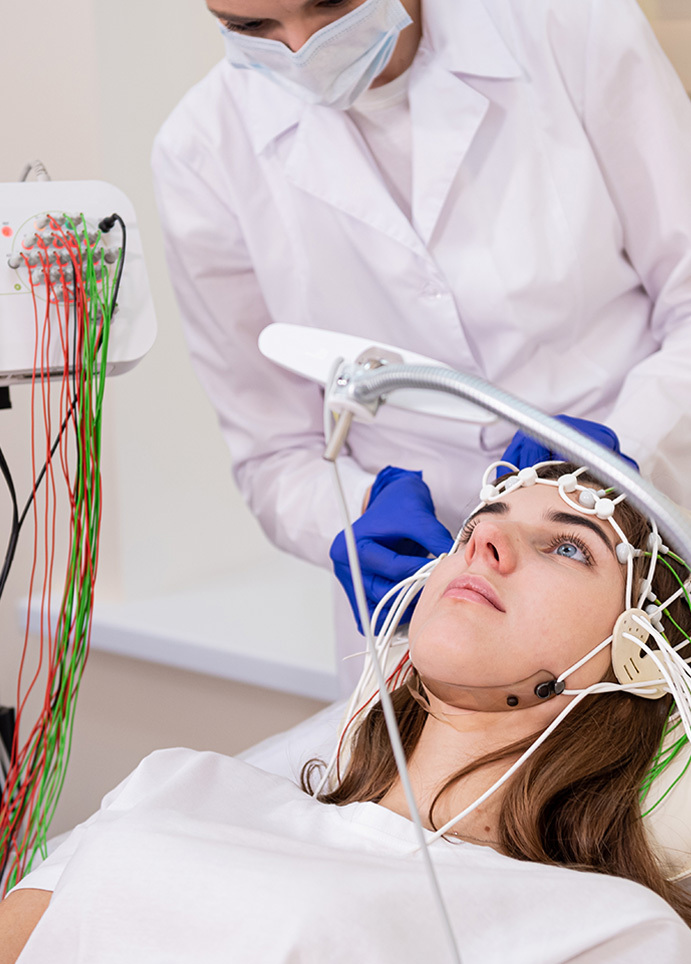Sleep Study Bangalore Provides expert Evaluation for Sleep Disorders
Exactly How a Sleep Study Can Change Your Sleep Patterns: Insights and Solutions Available
A sleep study acts as a necessary device for people seeking to recognize and improve their sleep patterns. It offers a thorough analysis of rest habits and potential disorders. By reviewing different metrics, healthcare professionals can identify underlying issues that interfere with corrective remainder. This process not just aids in diagnosis yet also sets the phase for customized therapy plans. What insights might a sleep research reveal about your very own rest habits?
Understanding Sleep Researches: What to Anticipate
When people prepare for a rest research, they usually wonder what the experience will require. These studies, normally performed in a rest facility, goal to check various physiological parameters during sleep. Upon arrival, participants are greeted by trained service technicians who assist them via the procedure. The setting is made to be comfy, permitting for an all-natural rest experience. Individuals might be asked to complete sets of questions concerning their rest habits and case history, which assists in the analysis.
As the evening advances, sensors are connected to the body to track mind waves, heart price, and breathing patterns. While the configuration may feel uncommon, the objective is to gather accurate information on the individual's rest patterns. The whole procedure is non-invasive and poses no risk to the participant. Eventually, the data collected throughout the rest research study is crucial for identifying prospective rest disorders and creating efficient therapy strategies.
Typical Sleep Disorders Recognized Through Sleep Researches
Rest research studies play a necessary function in recognizing different sleep problems that can substantially affect an individual's wellness and wellness. Common disorders discovered via these researches include obstructive rest apnea, defined by duplicated disturbances in breathing during rest, causing fragmented rest patterns. One more prevalent condition is sleep problems, which includes trouble falling or remaining asleep, commonly resulting in daytime tiredness and damaged functioning. Restless legs syndrome (RLS) is additionally frequently observed, creating uncomfortable feelings in the legs and an unmanageable urge to relocate them at night. Narcolepsy, a neurological problem that affects sleep-wake cycles, is an additional severe problem recognized in sleep research studies, leading to extreme daytime drowsiness and sudden sleep assaults. Ultimately, parasomnias, which incorporate abnormal habits throughout rest, such as sleepwalking or night fears, are additionally noted. Early identification of these problems can facilitate timely treatment and boost total rest quality.
The Refine of a Rest Research: From Prep Work to Results
The procedure of a sleep research might appear intimidating, it is a systematic and structured technique created to collect crucial details concerning a person's rest patterns. Originally, a health care provider conducts an extensive assessment, talking about sleep history and signs and symptoms with the patient. This analysis assists identify the particular focus of the research.
Preparation generally involves standards on sleep hygiene and drug modifications before the research. Clients may be instructed to stay clear of high levels of caffeine and alcohol to guarantee exact outcomes. On the night of the research, electrodes and sensing units are positioned to keep an eye on brain task, heart rate, breathing, and activities throughout sleep.
The information gathered is diligently evaluated by sleep specialists, that identify any kind of patterns or problems a sign of rest conditions. Following this evaluation, a follow-up examination is arranged to go over the findings and prospective therapy choices customized to the individual's demands, helping with better sleep high quality.

Kinds of Rest Studies: In-Lab vs. Home Rest Tests
Two key kinds of sleep researches exist: in-lab research studies and home sleep examinations, each satisfying various requirements and situations. In-lab researches generally happen in a rest center where individuals are monitored over night by health care experts. This technique enables extensive data collection on numerous sleep criteria, such as brain task, oxygen levels, and heart rate. Patients are commonly connected to numerous sensors, giving in-depth understandings into their rest disorders, including rest apnea and narcolepsy.
Conversely, home rest tests use a more practical alternative for individuals that prefer to carry out assessments in their very own setting. These portable gadgets monitor vital metrics like air movement, oxygen saturation, and snoring. While home tests are less thorough than in-lab research studies, they work as a practical option for detecting common sleep conditions. Inevitably, the selection in between these two kinds of rest researches depends on individual preferences, medical requirements, and the extent of sleep-related issues.
Translating Your Rest Research Study Outcomes: Trick Metrics Explained
Understanding the results of a sleep research study is crucial for patients seeking insights into their sleep health. Key metrics generally analyzed in sleep researches consist of the Apnea-Hypopnea Index (AHI), which measures the number of apneas and hypopneas per hour of rest. AHI worths aid establish the extent of rest apnea, with greater ratings suggesting a lot more considerable problems. One more essential metric is the total bedtime (TST), which reflects the overall period of rest throughout the study. Sleep performance, the ratio of time invested asleep to time invested in bed, is also important; higher percents show much better sleep quality. Additionally, the percent of rest spent in different phases-- light, deep, and rapid eye movement-- offers insights right into rest design. Comprehending these metrics gears up patients with the expertise required to discuss their rest patterns with doctor, leading the way for notified decisions about their rest health.
Treatment Options and Referrals Based on Your Rest Research
When a sleep study exposes problems such as rest apnea or other sleep conditions, numerous therapy choices and suggestions appear to improve general sleep wellness. For obstructive rest apnea, continual positive respiratory tract pressure (CPAP) treatment is frequently prescribed, giving a stable stream of air to maintain airways open throughout rest. Dental home appliances might be recommended for light to modest cases, rearranging the jaw to prevent air passage blockage.
In cases of sleep problems, cognitive behavioral therapy for insomnia (CBT-I) is usually suggested, concentrating on behavior changes and believed patterns that interfere with rest. Additionally, way of life adjustments such as weight-loss, normal workout, and avoiding alcohol or caffeine before going to bed might boost rest quality.

Structure Healthy Rest Behaviors: Tips for Better Rest
Building healthy rest routines is important for accomplishing corrective remainder. Establishing a constant rest regimen, restricting display helpful site time prior to bed, and creating a comfortable sleep environment can substantially improve sleep top quality. These approaches work as foundational steps for individuals seeking much better rest end results.
Develop a Sleep Routine
Establishing a regular rest regimen is important for promoting healthy sleep habits and improving general wellness. Sleep Study Bangalore. A routine sleep routine, where individuals go to bed and wake up at the exact same time each day, strengthens the body's natural circadian rhythms. This predictability assists control the sleep-wake cycle, resulting in enhanced sleep quality. Creating a calming pre-sleep routine, such as analysis or exercising leisure methods, can indicate the body that it is time to wind down. Additionally, optimizing the rest setting-- by keeping a comfy temperature level, decreasing noise, and making certain darkness-- can better sustain peaceful sleep. By prioritizing these practices, people can grow a sustainable sleep regimen that promotes restorative sleep and adds to much better psychological and physical health and wellness
Limit Display Time
As people progressively rely upon displays for amusement and interaction, restricting screen time prior to bed has become important for advertising much better sleep. Study indicates that exposure to blue light discharged by gadgets such as computer systems, tablet computers, and mobile phones can hinder the production of melatonin, the hormonal agent accountable for regulating sleep. Professionals recommend turning off displays at least one hour before going to bed to improve sleep top quality. Involving in different activities, such as practicing or checking out a publication leisure strategies, can help individuals take a break and prepare for sleep. By knowingly decreasing screen time, people can grow healthier rest patterns, causing boosted total well-being and raised daytime performance. Prioritizing this facet of rest hygiene is important for lasting health and wellness.
Develop a Rest Refuge
Creating a sleep sanctuary can substantially boost a person's ability to achieve restful sleep. This environment ought to prioritize comfort and serenity, incorporating elements that promote leisure. An appropriate bed mattress and pillows are crucial, as they straight influence rest high quality. Furthermore, the space ought to be dark, peaceful, and cool; utilizing blackout curtains and white noise machines can promote this ambience. Individualizing the room with relaxing shades and fragrances, such as lavender, can additionally improve relaxation. Minimizing clutter additionally adds to a tranquil atmosphere, enabling mental clearness - Sleep Study Bangalore. By thoughtfully developing a rest shelter, people can foster much healthier rest practices and develop a regular regimen, ultimately causing enhanced total health and corrective remainder
Regularly Asked Concerns
How much time Does It Require To See Improvements After a Sleep Research?
Improvements after a rest study can differ, however many individuals start to see positive changes within a couple of weeks. Consistent follow-up and adherence to advised treatments play vital roles in achieving optimal outcomes.

Can Kid Undergo Rest Studies, and Exactly How Are They Different?
Yes, children can undertake rest researches, which differ from adult researches in monitoring strategies and devices. Pediatric my link examinations typically involve child-friendly settings and might consist of parent involvement to assure comfort and precise outcomes.
Are Rest Studies Covered by Insurance, and What Are the Prices?
Rest studies can be covered by insurance coverage, depending upon the policy and clinical need. Expenses vary extensively, varying from $300 to $3,000, affected by the type of research and place of the center.
What Way Of Life Changes Can Boost the Efficiency of Rest Research Study Outcomes?

Carrying out regular sleep timetables, decreasing high levels of caffeine intake, developing a calming going to bed routine, and preserving a comfy sleep setting can substantially improve the performance of sleep research results, advertising better sleep top quality and overall health and wellness.
How Usually Should I Repeat a Rest Study for Ongoing Issues?
Individuals experiencing recurring rest issues ought to think about repeating a sleep research study every one to two years, or as suggested by medical care professionals, to keep an eye on adjustments and adjust treatment plans efficiently based upon their evolving sleep patterns. (Sleep Study Bangalore)
Sleep research studies play an important function in determining numerous rest problems that can significantly affect an individual's health and wellness. Typical conditions identified through these studies include obstructive sleep apnea, characterized by repeated interruptions in breathing during rest, leading to fragmented rest patterns. When a rest research discloses concerns such as rest apnea or various other rest conditions, different therapy choices and suggestions come to be available to improve overall rest wellness. Developing a regular rest regimen, restricting screen time before bed, and creating a comfy sleep environment can greatly improve sleep top quality. In addition, maximizing the sleep setting-- by preserving a comfortable temperature level, lowering noise, and making sure darkness-- can better support relaxed rest.